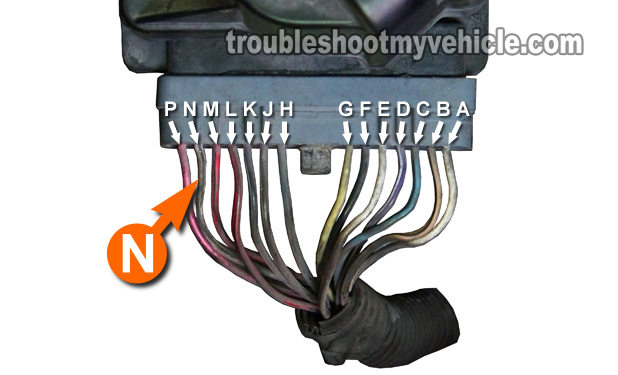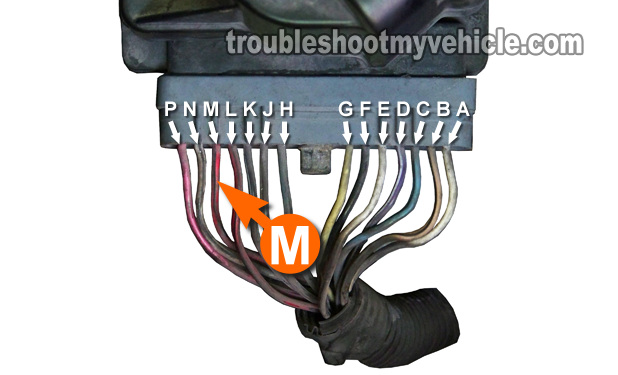CMP TEST 2: Power Circuit

Since the camshaft position sensor is a Hall Effect Type sensor, it needs a power and Ground source for it to work and produce a cam signal.
In this test, you'll be verifying that the camshaft position sensor is getting 10 Volts DC from the ignition control module (ICM), since it's the ICM that provides the juice the cam sensor needs.
You could use a 12 Volt automotive test light for this test but for a more accurate test result, I recommend you use a multimeter.
You'll also be testing for this voltage at the ignition control module (ICM) connector. OK, this is what you'll need to do:
- 1
The circuit (wire) that carries the 10 Volts DC to the camshaft position sensor is the one labeled with a letter N in the image above.
- 2
You'll need to pierce the wire with an appropriate tool and then connect the red multimeter test lead to this tool. I recommend using a wire-piercing probe to accomplish this.
- 3
Connect the black multimeter test lead to a good Ground point on the engine, preferably on the battery negative (-) terminal.
- 4
When everything is set up, place your multimeter in Volts DC mode and then have an assistant turn the key to the ON position. There's no need to crank the vehicle for this test, since voltage will be present with just the key in the ON position.
- 5
If all is OK with this circuit, then your multimeter will display 10 to 12 Volts DC.
Now, let's take a look at what those voltage readings (or lack of) mean:
CASE 1: The multimeter showed 10 Volts when the ignition was turned on. This multimeter result indicates that the cam sensor does have power.
The next test is to verify that the CMP sensor is getting a good Ground. Go to: CMP TEST 3: Ground Circuit.
CASE 2: The multimeter DID NOT show 10 Volts when the ignition was turned on. This result indicates that the ignition module is not supplying power to the camshaft position sensor.
What this result means is that the camshaft position sensor itself is not at fault or bad. Without these 10 Volts, the cam sensor will not work and produce a cam signal.
CMP TEST 3: Ground Circuit

The last electrical test of the GM 3.8L camshaft position sensor is to make sure that the 10 Volts that power it, have a good return path to Ground.
This Ground, just like the 10 Volts you tested in CMP TEST 2, is provided by the ignition control module (ICM) too.
For this test, I suggest that you don't use a test light. Use a multimeter.
Alright, these are the test steps:
- 1
The wire (coming out of the ignition control module) that supplies this Ground, is the one labeled with the letter M in the photo in the image viewer.
- 2
Pierce this wire with an appropriate tool and then connect the black multimeter test lead to this tool.
- 3
Now, connect the red multimeter test lead to the battery positive (+) terminal.
- 4
Place your multimeter in Volts DC mode and then have your helper turn the key to the ON position. The multimeter should register battery voltage (about 12.5 Volts).
Now, let's take a look at what those voltage readings (or lack of) mean:
CASE 1: The multimeter showed 12 Volts when the ignition was turned ON. This indicates that the camshaft position sensor is getting Ground.
Now, if in CMP TEST 1 you DID NOT get that one 5 - 6 Volt DC pulse on your multimeter and you did get 10 Volts to register in TEST 2, then the CMP sensor could be bad. Could be bad??? Well, there's one more test (and the last) to do to make sure it is bad.
The next test is to remove the cam sensor, from the engine timing cover, and visually check that the interrupter button hasn't fallen off of the cam gear. Go to: CMP TEST 4: Removing the CMP Sensor.
CASE 2: The multimeter DID NOT show 12 Volts when the ignition was turned ON This result indicates that the ignition module is not supplying a Ground path to the cam sensor.
It's very rare that the ignition control module not provide this Ground path, usually the most common cause of this no Ground test result is that the terminal inside the ignition control module connector has worked itself out and is not completely mating with the male spade terminal of the ignition control module (ICM).
